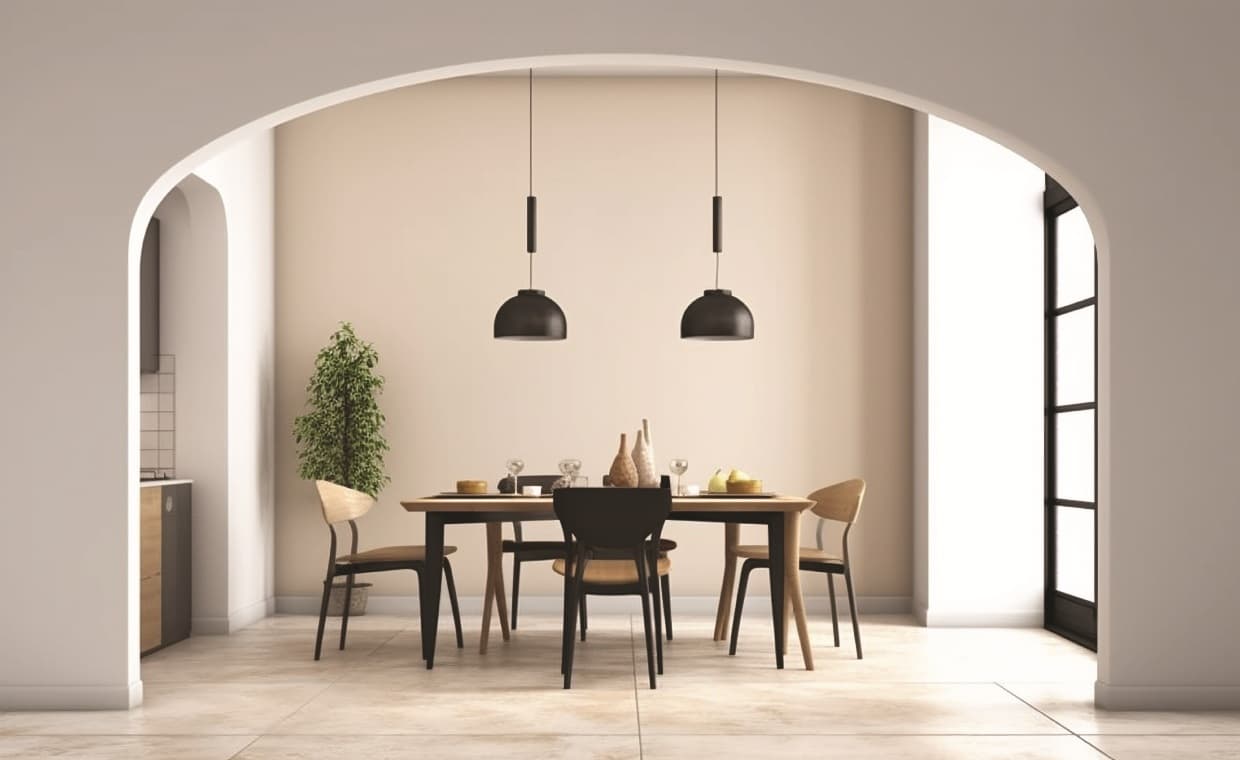
The essence of minimalist dining design lies in the harmonious balance of function and form. This design philosophy embraces simplicity, eliminating superfluous elements to highlight the inherent beauty of a space and its furnishings. Achieving this equilibrium involves a thoughtful approach to various aspects, from the colour scheme and furniture selection to spatial arrangements and personal touches.
A Comprehensive Guide on Creating a Minimalist Dining Area
This comprehensive guide delves into the nuances of creating a minimalist dining area that flawlessly merges practicality with aesthetics.
01. Simplicity in Color Scheme

Simplicity begins with color. In minimalist design, the color scheme forms the foundational canvas upon which all other elements come to life. Neutral colors reign supreme. Whites, blacks, greys, and beiges lend themselves to a serene atmosphere that complements the minimalist ethos.
A simplistic palette doesn’t just create a visually soothing ambiance – it also allows the shapes and textures within the room to take center stage. While these neutral shades dominate, subtle pops of color can breathe life into the space.
However, restraint is key. A single piece of vibrant artwork or a strategically placed colorful table runner can provide a delightful contrast without overwhelming the senses. The judicious use of colour enhances the visual appeal without sacrificing the minimalist ideal of tranquility.
02. Quality Over Quantity

When it comes to furnishing a minimalist dining room, the mantra of ‘quality over quantity’ prevails. The focus should be on investing in fewer high-quality pieces that offer both style and functionality.
For instance, extendable solid oak dining tables can be a perfect center piece, embodying durability, practicality, and timeless elegance. They provide a reliable place for meals while also standing as a work of art in their own right.
Meanwhile, the chairs need to offer comfort for prolonged seating, and their design should be in harmony with the table, following sleek lines and understated details. In this scenario, extravagance is found in the craftsmanship and the richness of materials rather than elaborate designs. Each piece of furniture should be a testament to excellence in construction, chosen deliberately for both its beauty and its utility.
03. Clutter-Free Environment

Maintaining a clutter-free environment is paramount in minimalist design. The philosophy centers around the concept that less is more, so every item in the dining room should serve a purpose. This goes beyond furniture to include table settings, decor, and even dinnerware. Tabletops are kept clear, perhaps adorned with just one or two pieces of simple decor, such as a sleek candleholder or a solitary vase.
This not only contributes to a clean aesthetic but also encourages a peaceful dining experience, free from the distractions of visual clutter. The minimalist approach doesn’t equate to bareness. Rather, it’s about the careful curation of items, ensuring everything present is both needed and appreciated.
04. Smart Storage Solutions

The pursuit of minimalism doesn’t mean foregoing storage. Instead, it calls for smart, integrated solutions. Seamless storage units such as sideboards or credenzas are vital in keeping essentials handy yet out of sight. These pieces, characterized by their sleek, straight lines, should blend effortlessly with the room’s aesthetics, almost as if they’re architectural elements rather than mere furniture.
The key lies in their subtlety – they’re there to provide functionality without drawing attention to themselves. Inside, essentials are organized efficiently—dinnerware, cutlery, and other necessities are stored within reach but hidden to maintain the uncluttered visage.
05. Lighting

Illumination plays a critical role in enhancing both the function and form of a minimalist dining space. Lighting should be simple yet strategic. Over the dining table, a statement pendant light can serve as a focal point—its design, although eye-catching, should still adhere to the minimalist ethos of simplicity.
The choice of lighting fixture can subtly influence the entire room’s ambiance, providing not just light but also acting as a piece of art. Additional lighting, like recessed lights or a tastefully designed floor lamp, can be incorporated for layered illumination, ensuring the space is adaptable for everything from morning breakfasts to intimate evening dinners.
Functionality is the key here – the lighting should be adjustable, perhaps with dimmer switches, to provide versatility in creating the desired dining atmosphere.
06. Textural Elements

Texture is the secret ingredient that adds depth and dimension to a minimalist dining room. Even within a restrained colour palette, the incorporation of varied materials introduces an understated complexity. Imagine the smooth coolness of a marble table contrasted with the warm grain of wooden chairs or the softness of upholstered seats juxtaposed with the hard lines of a metal light fixture.
These textural contrasts, though subtle, add a layer of sensory richness to the room, inviting inhabitants not just to see but to touch and feel. Furthermore, textiles, such as linen napkins or a woolen area rug, can introduce texture without clutter, enhancing comfort and warmth in the dining space.
07. Greenery

Introducing greenery to a minimalist dining area infuses the space with vibrancy and life. Plants, whether a potted indoor tree or a simple bouquet of fresh flowers, can provide a touch of organic beauty. They introduce a natural element that breaks the monotony, adding color and texture without straying from minimalist principles.
However, the approach remains focused on simplicity—a solitary, healthy plant can be more impactful than an overdone arrangement. The choice of the plant should reflect the overall design—clean lines and uncomplicated pots that complement, not distract. Besides their aesthetic contribution, plants also offer functional benefits, such as improved air quality and potential psychological well-being, enhancing the overall dining experience.
08. Functional Decor

Decor, when used in a minimalist context, must justify its existence through functionality. Every item should serve a practical purpose beyond its aesthetic appeal. A wall clock, for instance, can be both a timepiece and a decorative element. Similarly, a wall-mounted wine rack doesn’t just display a wine collection—it saves space and keeps bottles conveniently accessible.
When selecting decor, the focus should be on understated pieces that harmonize with the rest of the room. Even small touches, like elegant coasters or minimalist candle holders, contribute to the dining function while adding an element of design. This dual-purpose approach ensures no item is superfluous. Everything has a reason for occupying the space.
09. Space and Symmetry

Spatial arrangement and symmetry are underlying principles in minimalist design. The dining setup should allow for ease of movement, with furniture placed thoughtfully rather than crowded together. This might mean the dining set is centered in the room, surrounded by ample space, or situated near a window for natural light.
Symmetry, meanwhile, contributes to a sense of balance and tranquility. This could manifest in the way chairs are evenly spaced around the table or in the alignment of the pendant light above. However, perfect symmetry isn’t mandatory. Sometimes, slight deviations can create dynamic visual interest. What’s crucial is the sense of order—the room shouldn’t feel chaotic but should exude calmness and control.
10. Reflect Personal Style

Finally, while adhering to the principles of minimalism, the dining space should still reflect personal style. This isn’t a contradiction of minimalism but rather an acknowledgment that the room is still a personal space.
Incorporating elements that signify something to the inhabitants—be it a piece of inherited art, a set of handcrafted dinnerware, or a choice of a unique light fixture—adds immeasurable value. These personal touches infuse the room with character and history, making the dining experience not just about sustenance but a celebration of one’s identity and memories.
Final Thoughts
Achieving balance in a minimalist dining design revolves around a deliberate assembly of elements, each selected for its practicality while collectively contributing to an aesthetic whole. This approach encompasses a restrained color palette, quality furnishings, clutter-free surroundings, integrated storage, strategic lighting, and meaningful personal touches—all within a spacious, symmetrical layout.
By valuing simplicity and purpose in each choice, from decor to dinnerware, a minimalist dining space transcends mere functionality, embodying a serene, visually harmonious area that enriches the daily dining experience.






























